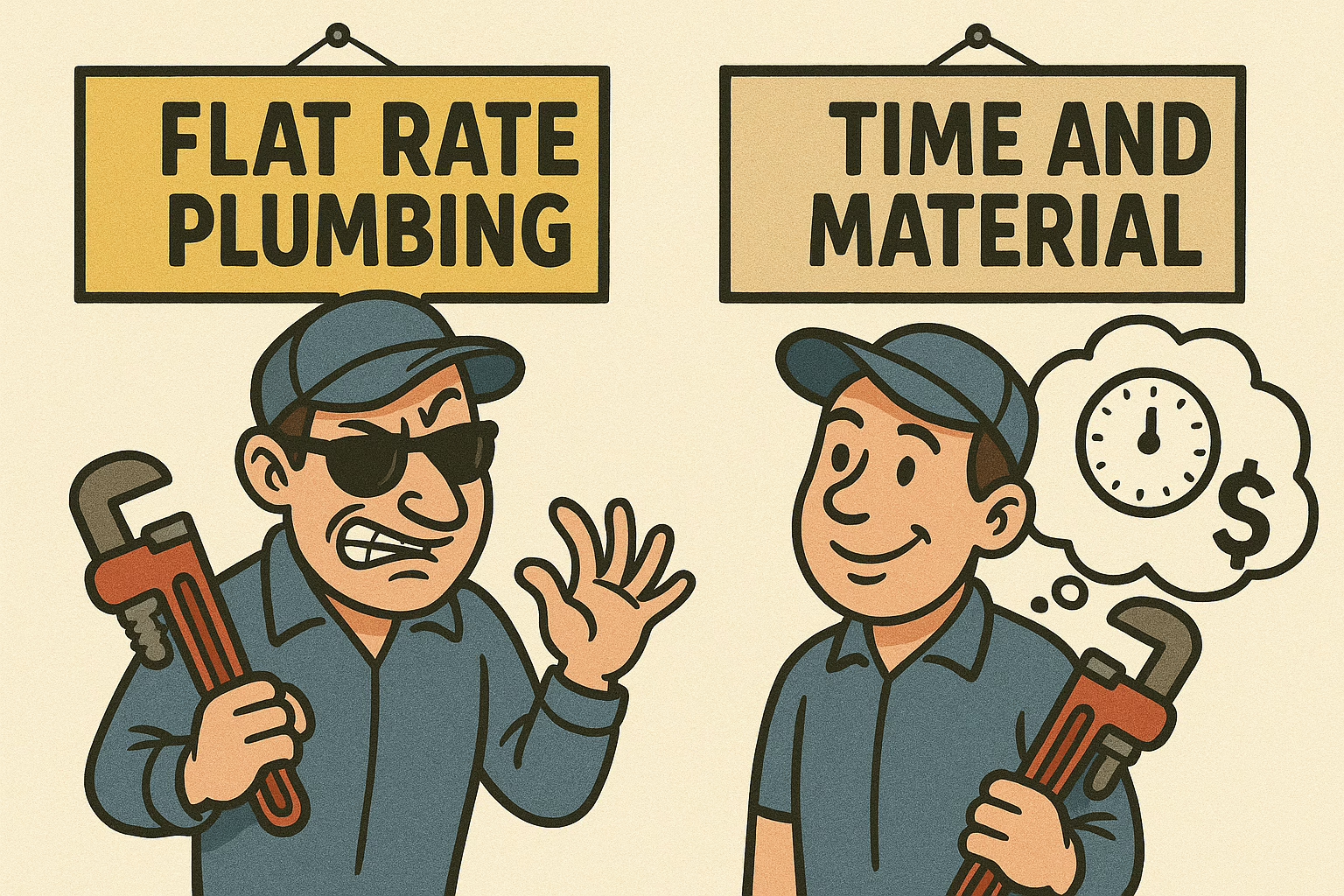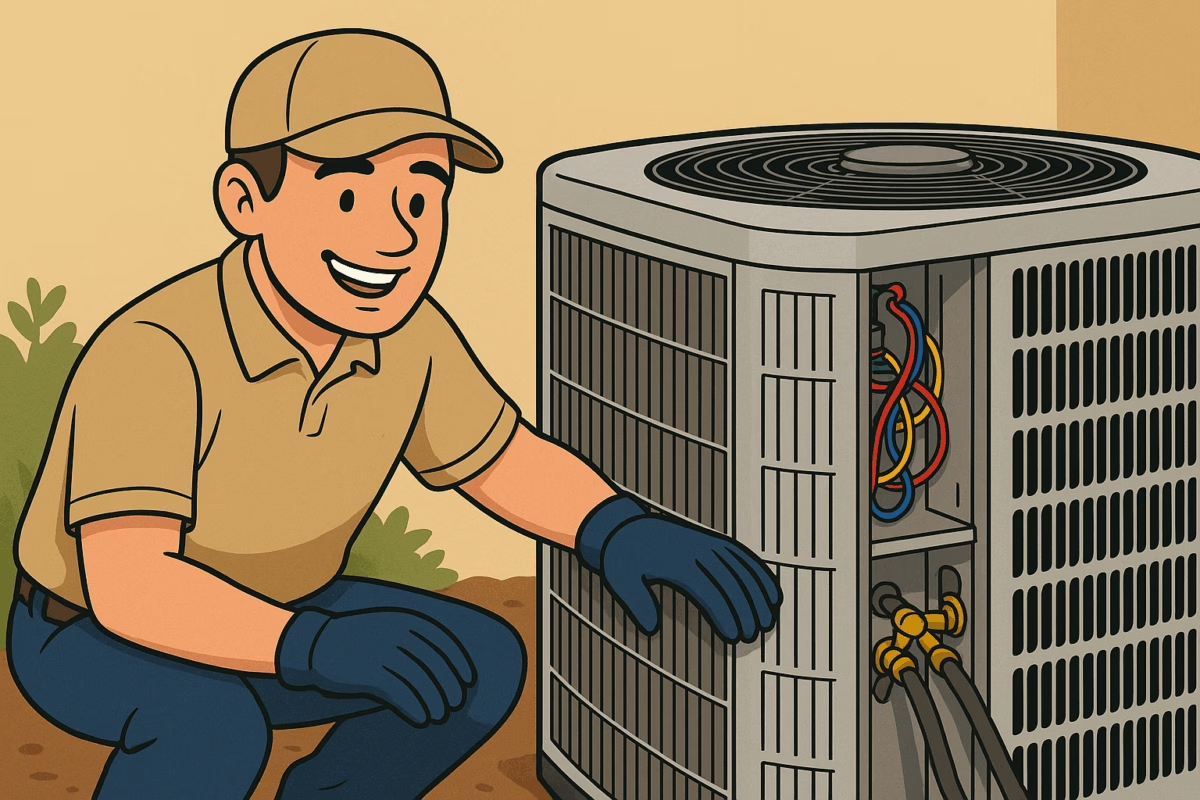Plumbing Flat Rate vs. Time & Material — Why T&M Often Wins Out
Choosing how to price plumbing work—flat rate vs. time & material—is more than a billing decision. It impacts cost, flexibility, and what you actually pay. While flat-rate pricing feels safe, plumbing’s inherent unpredictability often makes time & material (T&M) the more economical and fair option.
What Flat Rate and Time & Material Mean in Practice
- Flat Rate (Fixed Price): The plumber quotes a fixed cost for the entire job. No change even if unexpected challenges arise (unless renegotiated).
- Time & Material (T&M): You pay an hourly labor rate plus the exact cost of parts and supplies. If the job changes in real time, the contract adapts.
When complexity, surprises, or variable work conditions are involved, flat rate forces you to overpay for risk or else expose yourself to change orders. T&M lets you ride the ups and downs with more equity.
Why T&M Often Ends Up Cheaper (or at Least More Efficient)
- Avoid paying for worst-case padding. Flat rates often include extra buffer for unknowns. If the work is smoother, you’re still paying that buffer.
- Flexibility to adapt without renegotiation. Plumbing work rarely goes exactly to plan. Hidden leaks or pipe damage happen. With T&M, you only pay for what’s actually done.
- Transparency fosters accountability. You can see hours and parts. That visibility pressures the contractor to be efficient, rather than padding time.
- Savings when work is faster. If the job takes less time than expected, T&M rewards that efficiency. Flat-rate contracts rarely pass that saving to you.
- Use of “not-to-exceed” or hybrid caps. You can cap the maximum cost in a T&M contract while retaining flexibility. This mitigates runaway risk. (Wikipedia)
- Faster project starts. Less time spent drafting full scope pricing means work can begin sooner. (Procore)
Case Studies That Illustrate the Edge of T&M
- In a multifamily building plumbing study, comparing material and labor costs showed how install labor drove much of total expense—something flat pricing would obscure. (Uponor)
- A hotel plumbing cost analysis across piping systems (PEX, CPVC, copper) under a T&M framework demonstrated that the tradeoffs in labor hours could swing total cost significantly. (Uponor)
- A commercial plumbing time study recorded variance in install hours across systems and conditions, reinforcing that labor hours are hard to predict—and flat rates must carry big buffers. (REHAU)
- A Melbourne prefabrication experiment using DfMA (Design for Manufacture & Assembly) in bathroom modules reduced installation time and variation, showing the advantage of billing models that reward precise labor tracking (i.e. T&M). (ScienceDirect)
- A renovation decision to avoid extra labor (core drilling) in a drain rerouting job serves as a micro-example of how smart tradeoffs save hours—and money—in a model where you pay for time used. (Oatey)
These examples show that plumbing is rarely linear or predictable. The more you can track and adapt, the more you benefit. T&M is inherently better suited for that adaptability.
Flat Rate vs. T&M: Side-by-Side
| Criteria | Flat Rate | Time & Material |
|---|---|---|
| Upfront cost certainty | ✅ | ⚠️ Estimate or capped |
| Risk of overpaying | High (you pay for padding) | Low (you pay actuals) |
| Flexibility to adjust scope | Poor (requires change orders) | Excellent (built-in adaptability) |
| Incentive for contractor efficiency | Weak | Strong |
| Transparency | Low | High (itemized billing) |
| Best use case | Very simple, predictable tasks | Projects with variability, unknowns, or evolving needs |
Flat-rate contracts work best when you can define the job down to the detail—and there’s little chance of surprise. Plumbing often violates both of those conditions.
When Flat Rate Still Makes Sense — and Where T&M Dominates
Flat rate is reasonable when:
- The task is simple, well understood, and standardized (e.g., replacing a known faucet model).
- You absolutely need cost certainty.
- You have benchmarked rates and trust the contractor.
T&M is preferable when:
- There’s likely to be unknowns or surprises (older plumbing systems, restricted access, multiple possible repair paths).
- You want direct visibility and accountability.
- You accept some uncertainty in exchange for potentially lower cost.
- You use a hybrid or capped T&M to protect against runaway hours.
How to Evaluate T&M Quotes (and Make Them Work in Your Favor)
- Ask for a detailed labor rate (hourly or per labor unit).
- Check material markups or add-ons—be clear what’s added on top of cost.
- Include a “not-to-exceed (NTE)” clause, so there’s a defined ceiling.
- Require invoice transparency—line items showing hours and parts.
- Ask about change-order handling—how are unknowns priced?
- Evaluate contractor trustworthiness—reviews, references, reputation matter more under T&M.
- Compare multiple T&M bids (same job scope) to see variances in rates and assumptions.
If a plumber resists itemization or refuses to commit to transparency, that’s a red flag under T&M.
FAQs
Is T&M always cheaper?
No—but it often is in real plumbing jobs. When work is easier or faster than worst-case estimates, T&M gives you the upside; flat rate doesn’t.
Can we switch models mid-project?
It’s possible, but messy. Better to pick upfront—though you can build hybrid or capped T&M to retain flexibility.
Are hybrid models viable?
Absolutely. Many contractors use a base flat component for known tasks and T&M for uncertain ones. Or they use a T&M contract with a not-to-exceed cap. This gives you both flexibility and protection.
How do you guard against runaway costs in T&M?
Use a not-to-exceed clause, contractual check-ins or milestones, status reporting, and require detailed invoices. The transparency built into T&M serves as a built-in control.
Conclusion: T&M Often Delivers Better Value in Plumbing
Flat-rate pricing feels clean and safe—but in plumbing’s messy world of hidden variables, rigid quotes often cost you more than they save you. Time & Material pricing, by contrast, aligns you more closely with actual labor and parts, rewards efficiency, and gives flexibility when surprises emerge.
When combined with clear invoice transparency, a not-to-exceed ceiling, and a trustworthy contractor, T&M often becomes the smarter, more economical option.
Ask yourself, why are there paid programs to learn about flat rate pricing? Don’t just take our word for it, “The New Flat Rate” and “Profit Rhino” are just two examples of paid programs that teach contractors how to earn more money (take advantage of customers) with flat rate. Don’t be fooled!
How Does Val’s Plumbing & Heating Price Service Invoices?
At Val’s Plumbing & Heating, most service work is priced time & materials (T&M) because it’s the fairest, most transparent way to bill for real conditions on site. We do offer flat-rate pricing for water heater installs and a few select services, but T&M lets you pay only for the time and parts actually needed—no padded contingencies.
For larger projects, we always provide a formal quote. Big jobs deserve apples-to-apples comparisons, and a fixed proposal is the only practical way to give you upfront, comprehensive pricing.
If you call for a “price to clear a drain” (or any service), we’ll share our hourly rate and get to work quickly. Our team focuses on efficiency so you save money compared with one-size-fits-all flat fees. It’s ethical, honest, and transparent—every time.


